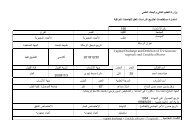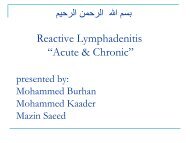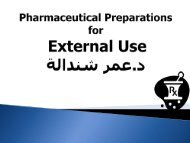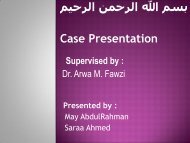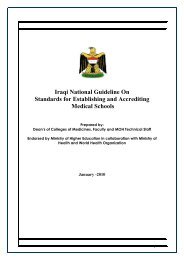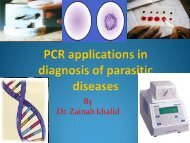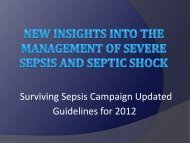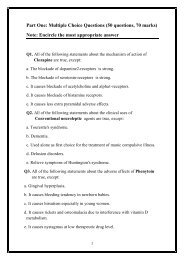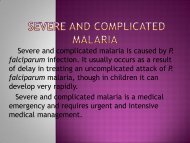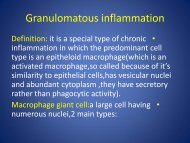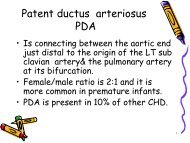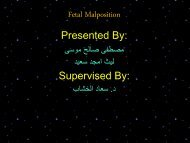Volume 35 June 2009 Number 1 - University of Mosul
Volume 35 June 2009 Number 1 - University of Mosul
Volume 35 June 2009 Number 1 - University of Mosul
You also want an ePaper? Increase the reach of your titles
YUMPU automatically turns print PDFs into web optimized ePapers that Google loves.
Annals <strong>of</strong> the College <strong>of</strong> Medicine Vol. <strong>35</strong> No. 1, <strong>2009</strong><br />
Effects <strong>of</strong> dairy-products' consumption on sebum<br />
lipids and fatty acids<br />
Y.Y. Al-Tamer *, A. A. Mahmood **<br />
* Department <strong>of</strong> Biochemistry, Nineveh College <strong>of</strong> Medicine; ** Department <strong>of</strong> Chemistry, College <strong>of</strong><br />
Education, <strong>University</strong> <strong>of</strong> <strong>Mosul</strong>.<br />
(Ann. Coll. Med. <strong>Mosul</strong> <strong>2009</strong>; <strong>35</strong>(1): 18-25).<br />
Received: 22 nd Jun 2008; Accepted: 25 th Jan <strong>2009</strong>.<br />
ABSTRACT<br />
Objectives: To investigate the effect <strong>of</strong> intake <strong>of</strong> dairy-products on the sebum lipid components and<br />
fatty-acid composition.<br />
Patients and Methods: Sebaceous cysts were obtained, by simple surgery, from the scalp, face and<br />
neck <strong>of</strong> 21 men (aged 25-50 y) and divided into two groups. The first group included 11 cysts for<br />
subjects consuming dairy products and the second group included 10 cysts for subjects not<br />
consuming dairy products. Simple lipids, phospholipids (PLs), triglycerides (TGs), cholesterol (C),<br />
cholesterol ester (CE) and fatty acids (FAs) were removed by organic solvents extraction. The sebum<br />
lipid components, TGs and C, were determined enzymatically and PLs were determined using a<br />
colorimetric method based on the formation <strong>of</strong> a phosphomolybdate complex. Lipid components were<br />
separated by TLC. The separated components were hydrolyzed and their FAs were esterified by<br />
super dried-acidified methanol. Fatty-acid methyl esters were identified by capillary gas<br />
chromatography.<br />
Results: Compared to the non-consumers group, the consumers group exhibited a significant<br />
increase in lipid contents, viz, PLs and C. Concerning the FA composition <strong>of</strong> CE, PLs and TGs, n 6 -<br />
polyunsaturated FAs showed a higher percentage, viz. C 18:2 n 6 and C 9 ,t 11 CLA, while n 3 -polysaturated<br />
FAs showed a significant decrease, viz. C 20:5 n 3 .<br />
Conclusion: Consumption <strong>of</strong> dairy products affects the lipid content and the FA composition <strong>of</strong><br />
sebum and C9,t11 Conjugated Linoleic Acid could be used as a marker for intake <strong>of</strong> dairy-product<br />
lipid.<br />
الخلاصة<br />
أهداف البحث: دراسة تأثير تناول الحليب ومشتقاته على المواد الدهنية وترآيبة الأحماض الدهنية لمحتويات الأآياس<br />
الدهنية<br />
العينات وطرائق العمل: تم الحصول على أآياس دهنية استئصلت بجراحة بسيطة من مناطق مختلفة من الجسم (الرأس،<br />
الوجه والعنق) من من الذآور تراوحت أعمارهم بين سنة تم تقسيم العينات الى مجموعتين، الأولى شملت<br />
آيسا دهنيا تم الحصول عليها من أشخاص يتناولون منتجات الحليب بصورة مستمرة في حين شملت المجموعة الثانية<br />
أآياس دهنية تم الحصول عليها من أشخاص لا يتناولون منتجات الحليب. تم قياس المكونات الدهنية لمحتويات الاآياس<br />
(الكليسيريدات الثلاثية بطريقة انزيمية، الدهون المفسفرة بطريقة لونية، الكولستيرول الكلي والكولستيرول المؤستر بطريقة<br />
انزيمية)، ثم تم تحليل الحوامض الدهنية لكل من هذه المكونات باستثناء الكولستيرول الحر، بعد فصلها بواسطة<br />
آروماتوآرافيا الشرائح الرقيقة، بطريقة آروماتوآرافيا الغاز السائل الشعري.<br />
.<br />
٥٠ – ٢٥<br />
٢١<br />
.<br />
١١<br />
١٠<br />
© <strong>2009</strong> <strong>Mosul</strong> College <strong>of</strong> Medicine 18




